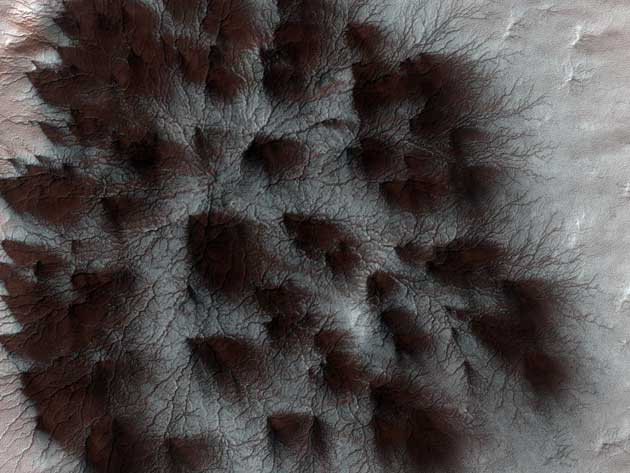Spring on Mars: warmer weather and lots of gas

Spring on Earth is marked by daffodils and budding leaves. However spring on Mars sees plumes of carbon dioxide vaporising from solid blocks of dry ice as they warm up in the sunlight towards the end of the Martian winter.
The unearthly nature of a Martian spring has been captured by Nasa's Mars Reconnaissance Orbiter satellite as it circles the Red Planet taking images of dirty plumes of gas carrying dust from the ground up through the openings of the solid carbon dioxide layer covering the Martian poles.
The seasonal polar caps on Mars form each winter because carbon dioxide in the atmosphere changes directly to frost, which builds up into a thick layer of dry ice as much as a metre thick.
As winter ends and spring arrives, the dry ice turns directly from solid into vapour which punches its way to the surface.
"Spring on Mars is quite different from spring on Earth because Mars has not just permanent ice caps, but also seasonal polar caps of carbon dioxide, familiar to us on Earth as dry ice," said Candice Hansen-Koharcheck, of Nasa's Jet Propulsion Laboratory in Pasadena, California.
"What happens on Mars, we think, is that as the seasonal ice cap thins from the bottom, gas underneath the cap builds up pressure. And where gas under the ice finds a weak spot or a crack, it will flow out of the opening, often carrying a little dust from the surface below," said Dr Hansen-Koharcheck.
Images from the High Resolution Imaging Experiment on board the satellite show how the dust patterns form into starburst patterns as they blow through the dry ice.
As the plumes of carbon dioxide emerge they form radial troughs called "spiders", so-called because of the way they look.
Join our commenting forum
Join thought-provoking conversations, follow other Independent readers and see their replies
Comments